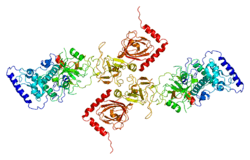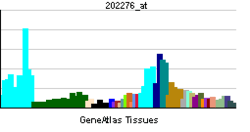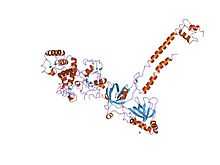SHFM1
| Split hand/foot malformation (ectrodactyly) type 1 | |||||||||||||
|---|---|---|---|---|---|---|---|---|---|---|---|---|---|
 PDB rendering based on 1iyj. | |||||||||||||
| |||||||||||||
| Identifiers | |||||||||||||
| Symbols | SHFM1 ; DSS1; ECD; SEM1; SHFD1; SHSF1; Shfdg1 | ||||||||||||
| External IDs | OMIM: 601285 MGI: 109238 HomoloGene: 38165 GeneCards: SHFM1 Gene | ||||||||||||
| |||||||||||||
| RNA expression pattern | |||||||||||||
 | |||||||||||||
| More reference expression data | |||||||||||||
| Orthologs | |||||||||||||
| Species | Human | Mouse | |||||||||||
| Entrez | 7979 | 20422 | |||||||||||
| Ensembl | ENSG00000127922 | ENSMUSG00000042541 | |||||||||||
| UniProt | P60896 | P60897 | |||||||||||
| RefSeq (mRNA) | NM_006304 | NM_009169 | |||||||||||
| RefSeq (protein) | NP_006295 | NP_033195 | |||||||||||
| Location (UCSC) | Chr 7: 96.11 – 96.34 Mb | Chr 6: 6.56 – 6.58 Mb | |||||||||||
| PubMed search | |||||||||||||
26S proteasome complex subunit DSS1 is a protein that in humans is encoded by the SHFM1 gene.[1][2][3]
The product of this gene has been localized within the split hand/split foot malformation locus SHFM1 at chromosome 7. It has been proposed to be a candidate gene for the autosomal dominant form of the heterogeneous limb developmental disorder split hand/split foot malformation type 1. In addition, it has been shown to directly interact with BRCA2. It also may play a role in the completion of the cell cycle.[3]
Interactions
SHFM1 has been shown to interact with BRCA2.[4][5]
References
- ↑ Roberts SH, Hughes HE, Davies SJ, Meredith AL (October 1991). "Bilateral split hand and split foot malformation in a boy with a de novo interstitial deletion of 7q21.3". J Med Genet 28 (7): 479–481. doi:10.1136/jmg.28.7.479. PMC 1016960. PMID 1895319.
- ↑ Crackower MA, Scherer SW, Rommens JM, Hui CC, Poorkaj P, Soder S, Cobben JM, Hudgins L, Evans JP, Tsui LC (June 1997). "Characterization of the split hand/split foot malformation locus SHFM1 at 7q21.3-q22.1 and analysis of a candidate gene for its expression during limb development". Hum Mol Genet 5 (5): 571–579. doi:10.1093/hmg/5.5.571. PMID 8733122.
- ↑ 3.0 3.1 "Entrez Gene: SHFM1 split hand/foot malformation (ectrodactyly) type 1".
- ↑ Marston, N J; Richards W J; Hughes D; Bertwistle D; Marshall C J; Ashworth A (July 1999). "Interaction between the product of the breast cancer susceptibility gene BRCA2 and DSS1, a protein functionally conserved from yeast to mammals". Mol. Cell. Biol. (UNITED STATES) 19 (7): 4633–42. ISSN 0270-7306. PMC 84261. PMID 10373512.
- ↑ Yang, Haijuan; Jeffrey Philip D; Miller Julie; Kinnucan Elspeth; Sun Yutong; Thoma Nicolas H; Zheng Ning; Chen Phang-Lang; Lee Wen-Hwa; Pavletich Nikola P (September 2002). "BRCA2 function in DNA binding and recombination from a BRCA2-DSS1-ssDNA structure". Science (United States) 297 (5588): 1837–1848. doi:10.1126/science.297.5588.1837. PMID 12228710.
Further reading
- Sharland M, Patton MA, Hill L (1991). "Ectrodactyly of hands and feet in a child with a complex translocation including 7q21.2". Am. J. Med. Genet. 39 (4): 413–414. doi:10.1002/ajmg.1320390410. PMID 1877619.
- "Toward a complete human genome sequence". Genome Res. 8 (11): 1097–108. 1999. doi:10.1101/gr.8.11.1097. PMID 9847074.
- Jäntti J; Lahdenranta J; Olkkonen VM et al. (1999). "SEM1, a homologue of the split hand/split foot malformation candidate gene Dss1, regulates exocytosis and pseudohyphal differentiation in yeast". Proc. Natl. Acad. Sci. U.S.A. 96 (3): 909–914. doi:10.1073/pnas.96.3.909. PMC 15324. PMID 9927667.
- Marston NJ; Richards WJ; Hughes D et al. (1999). "Interaction between the product of the breast cancer susceptibility gene BRCA2 and DSS1, a protein functionally conserved from yeast to mammals". Mol. Cell. Biol. 19 (7): 4633–42. PMC 84261. PMID 10373512.
- Yang H; Jeffrey PD; Miller J et al. (2002). "BRCA2 function in DNA binding and recombination from a BRCA2-DSS1-ssDNA structure". Science 297 (5588): 1837–1848. doi:10.1126/science.297.5588.1837. PMID 12228710.
- Strausberg RL; Feingold EA; Grouse LH et al. (2003). "Generation and initial analysis of more than 15,000 full-length human and mouse cDNA sequences". Proc. Natl. Acad. Sci. U.S.A. 99 (26): 16899–16903. doi:10.1073/pnas.242603899. PMC 139241. PMID 12477932.
- Scherer SW; Cheung J; MacDonald JR et al. (2003). "Human chromosome 7: DNA sequence and biology". Science 300 (5620): 767–772. doi:10.1126/science.1083423. PMC 2882961. PMID 12690205.
- Hillier LW; Fulton RS; Fulton LA et al. (2003). "The DNA sequence of human chromosome 7". Nature 424 (6945): 157–164. doi:10.1038/nature01782. PMID 12853948.
- Sone T, Saeki Y, Toh-e A, Yokosawa H (2004). "Sem1p is a novel subunit of the 26 S proteasome from Saccharomyces cerevisiae". J. Biol. Chem. 279 (27): 28807–28816. doi:10.1074/jbc.M403165200. PMID 15117943.
- Gerhard DS; Wagner L; Feingold EA et al. (2004). "The status, quality, and expansion of the NIH full-length cDNA project: the Mammalian Gene Collection (MGC)". Genome Res. 14 (10B): 2121–2127. doi:10.1101/gr.2596504. PMC 528928. PMID 15489334.
- Rual JF; Venkatesan K; Hao T et al. (2005). "Towards a proteome-scale map of the human protein-protein interaction network". Nature 437 (7062): 1173–1178. doi:10.1038/nature04209. PMID 16189514.
- Baillat D; Hakimi MA; Näär AM et al. (2005). "Integrator, a multiprotein mediator of small nuclear RNA processing, associates with the C-terminal repeat of RNA polymerase II". Cell 123 (2): 265–276. doi:10.1016/j.cell.2005.08.019. PMID 16239144.
- Kharrat N, Ayadi I, Rebaï A (2007). "Sample size computation for association studies using case-parents design". J. Genet. 85 (3): 187–191. doi:10.1007/BF02935329. PMID 17406092.
| |||||||||||||


